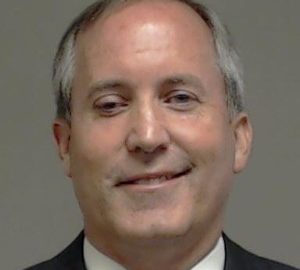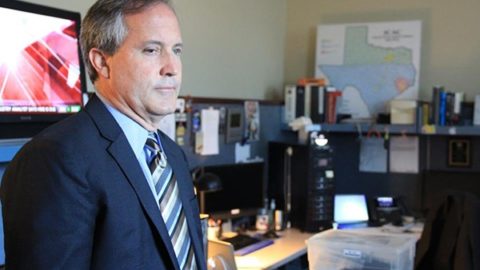Justin Nelson, the Democratic nominee for Texas Attorney General this year, has made combating partisan gerrymandering of congressional and legislative districts the No. 2 focus of his campaign.
It is right behind Number 1, which is Nelson’s continual reference to the fact that the incumbent Republican Attorney Gen. Ken Paxton has been under indictment for commercial fraud for three years.
Nelson, an Austin attorney and part-time law professor at The University of Texas, has been illustrating the partisan gerrymandering argument by holding “Walk the Lines to End Gerrymandering” – pub crawls in Austin and elsewhere in areas where the Republican-dominated Legislature had cut up neighborhoods into several different congressional districts.
He also hosted a rally July 29 at Austin’s famed blues joint Antone’s to call in Congressman Doggett and several Democratic candidates for other congressional districts in Travis County – districts all currently represented by Republicans – to call attention to the use of redistricting to benefit the party in control over the other.
“Gerrymandering undermines the integrity of our democracy,” Nelson argues. “Voters should choose their politicians, not the other way around.”
Paxton finds himself, as attorney general, in the position of defending the districts as drawn by the Legislature against cases by Democratic and minority groups. They contend that partisan redistricting is itself unlawful – a major topic in other states as well.
Paxton argues – as did his predecessor attorney general, Gov. Greg Abbott – that the districts do not discriminate by race, but only party. It is just incidental that minority voters tend to lean Democratic.
How partisan gerrymandering affects the composition of legislative bodies – including Congress – was described a few years ago by one of Texas’s best former politicians, former Texas Comptroller John Sharp.
Sharp, now the chancellor of Texas A&M University, freshly returned from a trip to Washington, D.C., was asked how things are in Congress.
“Oh,” he replied, “Everyone’s looking over their shoulder. The Republicans are looking over their right shoulder, and the Democrats are looking over their left.”
What that meant, basically, is that because of partisan gerrymandering, districts in many states are drawn to favor the party in control in that state. In each of those states, almost all of the districts are drawn so that the winner of the party primary in a district is almost a guarantee to win the general election.
So, as Sharp pointed out, congressional incumbents who want to come back for another term are moving as far to the left or right as necessary in their respective party primaries to stave off competitors from outflanking them.
And the result of that, as we have seen in Congress for the past several years, is gridlock. There are enough members of Congress representing the poles of their parties that they are unlikely to agree on very much.
And that, in turn, produces a legislative body populated by many members from the far right, and the far left – and the middle largely disappears. “Compromise” becomes a dirty word. Presidential leadership is virtually impossible. (Ask Barack Obama.)
And so for the large number of citizens who would appreciate some middle-of-the-road, common-sense, problem-solving compromises, they are out of luck.
Here’s how partisan gerrymandering works:
If the Republicans are in control, they will “pack” as many Democrats as they can in a Democratic stronghold, and “crack” up the Democrats in the area surrounding that district.
The result is to maximize the number of Republican districts and minimize the number of Democratic ones – most of which will be safely won by one party or the other, and be noncompetitive in the general election.
An example is Travis County, a Democratic-dominated area where the Texas capitol is located. It has one Democratic congressman: Lloyd Doggett.
The remainder of the county is parceled out to five other congressmen, Republicans whose districts reach from just south of Fort Worth to Houston to the border with Mexico and well into West Texas.
There are also some states where the Democrats are in control, where the process is reversed to maximize Democratic representation and minimize Republican clout.
Cases from both sides of the political aisle have been rattling around at the Supreme Court, but so far, the high court has not made any conclusive moves.
Several states have set up independent commissions or other means to separate the drawing of legislative and congressional districts from the state legislators who have traditionally drawn them. People have realized that legislators may be reluctant to change the system under which they were elected in the first place.
Half a dozen states have set up independent bodies to deal with congressional redistricting, and 13 states have set up outside commissions or other methods to deal with legislative districts, according to the National Conference of State Legislatures.
Several other states – including Michigan, Missouri, Colorado and Utah – have ballot initiatives this year to set up such outside bodies, aimed at drawing districts that are not driven so much by the party in charge and are less likely to resemble a map of the Philippine Islands.
Some groups in Texas, including the League of Women Voters and the Texas Civil Rights Project, are also pushing for Texas to join in that movement. Some efforts have been attempted in the past regular legislative session, to no avail.
Look for this battle to continue – and in Texas with an added focus from the attorney general’s race.
Article by Dave McNeely • View on The Victoria Advocate



